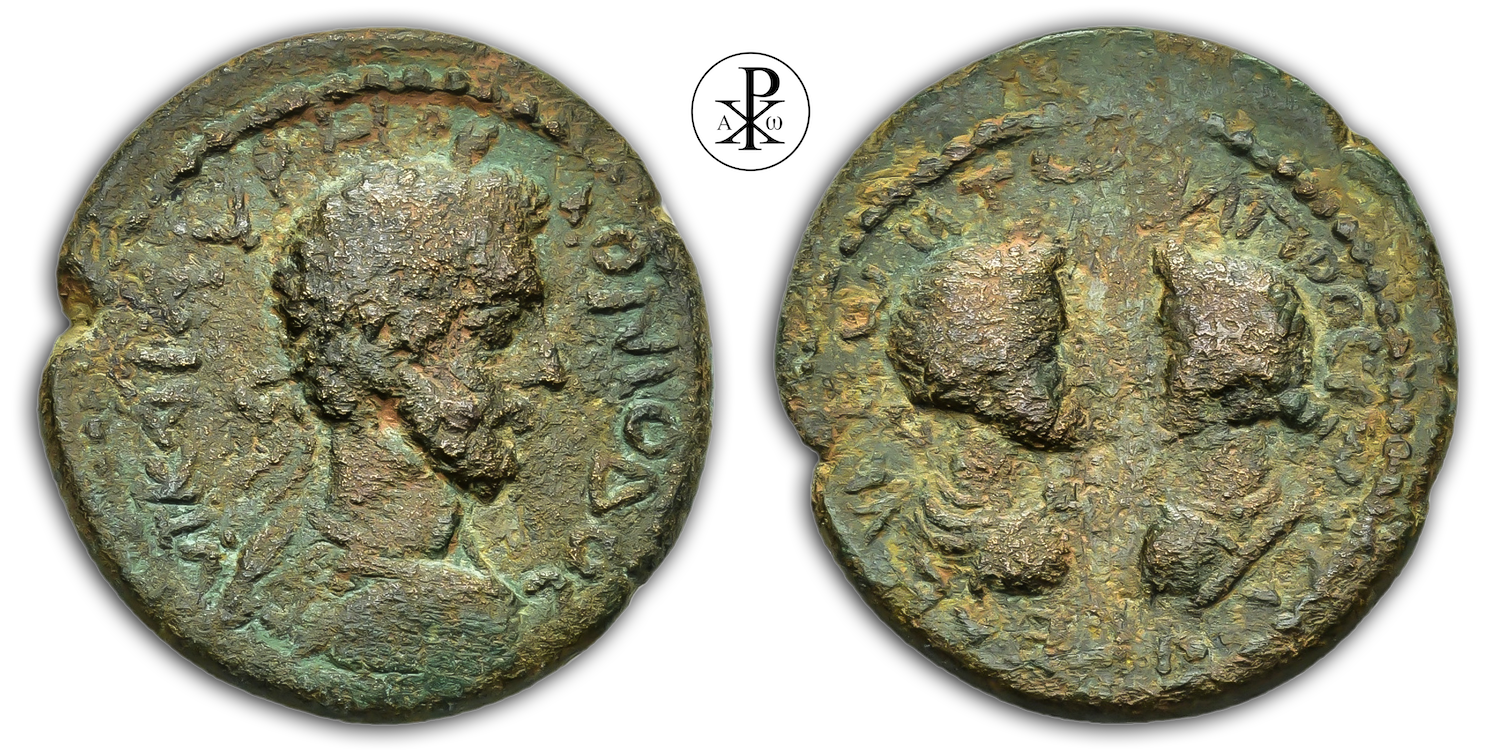Imperator Caesar Marcus Aurelius Commodus Antoninus Augustus
Reign: Commodus
Mint: Seleucia ad Calycadnum, Cilicia
Date: 180/182 AD
Nominal: Bronze
Material: AE
Diameter: 25mm
Weight: 8.78g
Reference: RPC IV.3 5836 (#6 this coin)
RPC Online: https://rpc.ashmus.ox.ac.uk/coins/4/5836
Rare: Specimens 6 (3 in the core collections)
Provenance: N&N Numismatics London, Great Britain (Auction 17, Lot 375)
Pedigree: –
Obverse: Laureate-headed bust of Commodus wearing cuirass and paludamentum, right
Inscription: ΑVΤ ΚΑΙ ΑVΡΗ ΚΟΜΟΔΟϹ
Translation: Autokrator Kaisaros Aurelios Komodos
Translation: Imperator Caesar Aurelius Commodus
Reverse: Confronted busts of Commodus (stylised Apollo) right, laureate-headed wearing cuirass and paludamentum, and Crispina (stylised Artemis) left, draped and with quiver over shoulder
Inscription: ϹƐΛƐΥΚƐⲰΝ ΤⲰΝ ΠΡοϹ ΤⲰ ΚΑΛV[ΚΑΔΝⲰϹ]
Translation: Seleύkeón tón pros tói Kalύkadnos
Translation: Seleucia from on the Kalydanos (lat. Seleucia ad Calycadnum)
Comment: Located a few miles from the mouth of the Kalydanos (today Göksu) River, Seleucia (modern Silifke) was founded by Seleucus I Nicator in the early 3rd century BC, one of several cities he named after himself. It is probable that there were already towns called Olbia (or Olba) and Hyria and that Seleucus I merely united them giving them his name. The inhabitants of Holmi were resettled here (Stephanos of Byzantium; Strabon 14, 670). According to Stephanos of Byzantium, the ancient name of Seleucia was Huria. William Foxwell Albright wants to equate Seleucia with the Hittite Ura, in which André Lemaire and Hélène Lozachmeur have followed him. The new city up river was doubtless seen as safer against attacks from the sea so Seleucia achieved considerable commercial prosperity as a port for this corner of Cilicia (later named Isauria), and was even a rival of Tarsus. Cilicia thrived as a province of the Romans, and Seleucia became a religious center with a renowned 2nd century Temple of Jupiter. It was also the site of a noted school of philosophy and literature, the birthplace of peripatetics Athenaeus and Xenarchus. The stone bridge was built by the governor L. Octavius Memor in 77 AD. Under the Romans, Seleucia (lat. Seleucia ad Calycadnum) became the capital of Isauria. Around 300 AD Isauria was established as an independent state with Seleucia as the capital. Emperor Frederick Barbarossa drowned in 1190 AD on the Third Crusade near the town of Seleucia in the river Kalydanos, which was then called Saleph and was in the Armenian-Kilician principality allied with Frederick. Today visitors can visit the ruins of a Roman theatre and a temple.
Apollo and Artemis, born as twin siblings, are children of Leto, who was seduced by Zeus. Artemis (Roman Diana) was born first. Immediately afterwards she assisted her mother in the birth of her twin brother Apollo. Artemis is the virgin goddess of hunting and nature. She is averse to love and coquetry. On the one hand she is the goddess of chastity, but also the goddess of vegetation and fertility, also the goddess of marriage and birth. Apollo, beautiful young god of light (sometimes equated with Helios), god of wisdom and prophecy, took over the oracle site in Delphi after Themis. He guides the Muses and is the god of atonement and the remover of evils. Apollo wears the laurel wreath as a sign of self-conquest. In Ovid’s “Metarmorphoses” it is reported that Daphne, the daughter of the river god Peneios, transformed herself into a laurel tree at her request to her father in order to avoid Apollo’s wooing. Apollo wove a laurel wreath from the leaves of the tree. The laurel has been sacred to him ever since.
